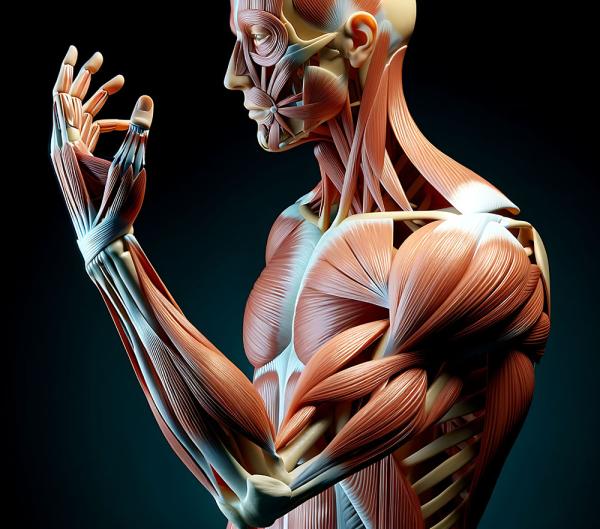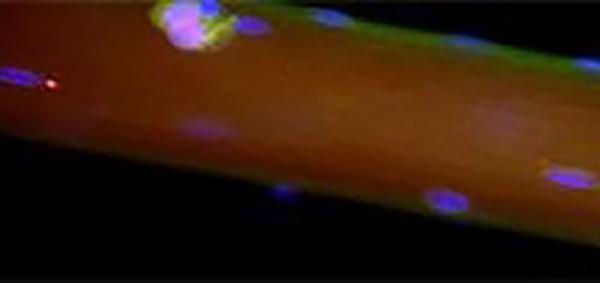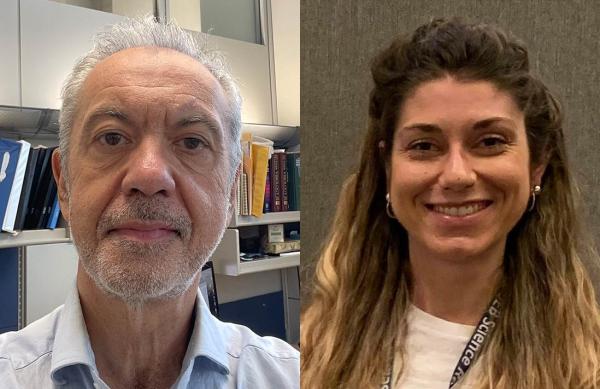Creating Building Blocks for Muscle Regeneration
IRP Study Points to Strategy to Speed Healing and Reduce Age-Related Atrophy

New IRP research could lead to new ways to help people regenerate muscle.
Whether due to exercise or injury, our muscles are constantly breaking down and regenerating. Just like construction workers need a hearty lunch to fuel their hammer swings and nails to hammer, our cells need both energy and specific materials to rebuild our bodies. New IRP research has produced important insights into how cells create the energy and building blocks needed to repair our muscles, pointing to potential avenues for helping people recover from muscular injuries or retain more muscle as they age.1
It's not hard to appreciate the sheer power of the long fibers that make up our muscles, but the stem cells that lay quietly amongst those fibers are easy to forget about. After all, those cells spend most of their time just loafing around. However, this seeming laziness belies their capacity to spring into action when needed.
“Usually, the muscle stem cells are in a ‘quiescent’ state, so they are kind of sleeping, but when you have an injury, the stem cells wake up and start to divide and migrate to the injury site to repair the muscle,” explains the new study’s first author, Veronica Ciuffoli, Ph.D., a postdoctoral fellow in the lab of IRP senior investigator Vittorio Sartorelli, M.D.
For a long time, scientists thought that dormant muscle stem cells met their low energy needs via a process called glycolysis, but studies done in Dr. Sartorelli’s lab tell a different story. Those experiments suggested muscle stem cells burn fats while dormant and only rev up glycolysis when they are called upon to repair damaged muscle because, while it is not a very efficient way to produce energy, it works very quickly and has the added benefit of creating the raw materials our cellular repairmen need to do their job.

Our muscles contain both long muscle fibers and stem cells (pink) that help repair muscle damage.
“The stem cells have to divide, they have to do it fast, and they have to generate not only energy, but also biomass — building blocks needed to regenerate the muscle,” says Dr. Sartorelli, the study’s senior author.
Those building blocks include serine, one of the many ‘amino acids’ that are strung together to make proteins. In the new study, a team of IRP researchers led by Dr. Ciuffoli and Dr. Sartorelli looked into how the production of serine affected muscle stem cells’ ability to divide and repair damaged muscle in mice. To their surprise, it turned out not to be the serine itself that muscle stem cells needed to make, but rather various other materials the cells generated on the way to making serine: specifically, a molecule called alpha-ketoglutarate and a different amino acid called glutamine.
“Our findings do not imply that serine is not important,” Dr. Sartorelli says, “but rather that cells may be able to compensate for the absence of serine by importing more serine from outside the cell. However, what the cells cannot compensate for is the absence of alpha-ketoglutarate that is produced during the process of generating serine.”

Dr. Sartorelli (left), the study’s senior author, and Dr. Ciuffoli (right), the study’s first author
One of the enzymes cells need to manufacture serine is Psat1, but Psat1 also has a side hustle producing alpha-ketoglutarate, a necessary ingredient for making glutamine. The IRP researchers found that a lack of Psat1 caused levels of alpha-ketoglutarate to drop in muscle stem cells extracted from mice and reduced the cells’ ability to divide. On the other hand, boosting the activity of Psat1 ramped up stem cell division. What’s more, mice without the gene for Psat1 showed an impaired ability to regenerate damaged muscle, but when the IRP scientists gave either alpha-ketoglutarate or glutamine to those mice, their muscles recovered from injury much more effectively.
Of course, muscles can degrade not only due to injury but also because of aging. Consistent with this phenomenon, the IRP team showed that older mice had lower levels of Psat1 and alpha-ketoglutarate in their muscle cells than younger mice, and the cells were less capable of generating energy via glycolysis. As a result, the muscles of older mice did not regenerate after injury as much as those of younger mice. However, injections of alpha-ketoglutarate or glutamine improved muscle regeneration in older mice. The treatment also tamped down a process known as fibrosis that the body uses to fill in empty space with scar tissue.
“If you look at the muscles of older people, you see a lot of fibrosis,” Dr. Sartorelli says. “They have muscles that are not only smaller, but also a good proportion of them is not muscle; it’s fibrotic tissue. When you want to contract the muscle, if you have a lot of fibrotic tissue, that’s not good because that tissue doesn’t participate in contraction.”
Altogether, the IRP team’s discoveries about Psat1, alpha-ketoglutarate, and glutamine suggest potential new ways to help people recover from muscle injuries or surgical procedures that damage muscle. What’s more, treatment with alpha-ketoglutarate or glutamine could one day help slow or reverse the natural muscular atrophy that accompanies aging.

The IRP study suggests alpha-ketoglutarate or glutamine could help people retain muscle mass as they age.
Of course, our muscles need more than just muscle fibers to be healthy. For that reason, Dr. Ciuffoli and Dr. Sartorelli are now investigating the roles of alpha-ketoglutarate and glutamine in the regeneration of other cell types found in our muscles. After all, a muscle cell with nothing around to support it is like a construction worker that forgot his toolbelt.
“When you have an injury in the muscle, you have to regenerate muscle cells, but you also have to regenerate other components like blood vessels,” Dr. Sartorelli says. “If you don’t have blood vessels that bring in nutrients and immune cells, then you don’t regenerate. We want to know whether the alpha-ketoglutarate produced by muscle stem cells is secreted from the cells, and if it’s secreted, does it influence the ability of other cell types to divide in a process that is required to heal the whole muscle. If that’s the case, you could consider muscle stem cells as a hub or a center that instructs and helps other cell types that have to work together to reconstruct the muscle.”
Subscribe to our weekly newsletter to stay up-to-date on the latest breakthroughs in the NIH Intramural Research Program.
References:
[1] Ciuffoli V, Feng X, Jiang K, Acevedo-Luna N, Ko KD, Wang AHJ, Riparini G, Khateb M, Glancy B, Dell'Orso S, Sartorelli V. Psat1-generated α-ketoglutarate and glutamine promote muscle stem cell activation and regeneration. Genes Dev. 2024 Mar 22;38(3-4):151-167. doi: 10.1101/gad.351428.123.
Related Blog Posts
This page was last updated on Tuesday, September 10, 2024
